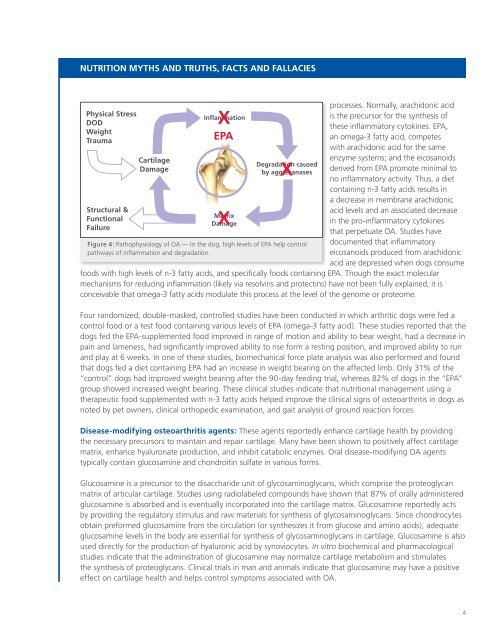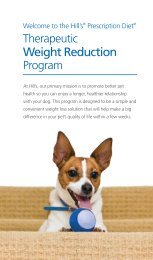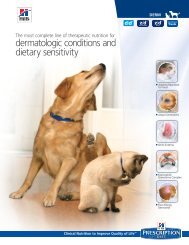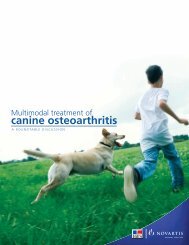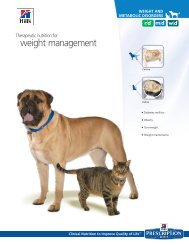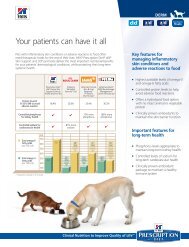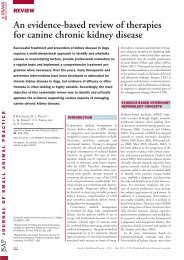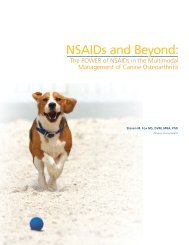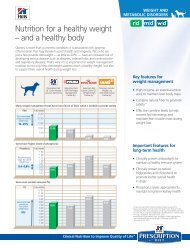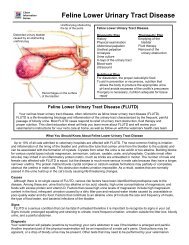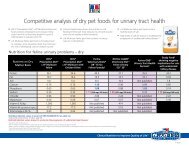using nutrition to ease the pain of osteoarthritis - HillsVet
using nutrition to ease the pain of osteoarthritis - HillsVet
using nutrition to ease the pain of osteoarthritis - HillsVet
Create successful ePaper yourself
Turn your PDF publications into a flip-book with our unique Google optimized e-Paper software.
<strong>nutrition</strong> myths and truths, facts and fallacies<br />
Physical Stress<br />
DOD<br />
Weight<br />
Trauma<br />
Structural &<br />
Functional<br />
Failure<br />
Cartilage<br />
Damage<br />
X<br />
Inflammation<br />
EPA<br />
X<br />
Matrix<br />
Damage<br />
Degradation caused<br />
by aggrecanases<br />
processes. Normally, arachidonic acid<br />
is <strong>the</strong> precursor for <strong>the</strong> syn<strong>the</strong>sis <strong>of</strong><br />
<strong>the</strong>se inflamma<strong>to</strong>ry cy<strong>to</strong>kines. EPA,<br />
an omega-3 fatty acid, competes<br />
with arachidonic acid for <strong>the</strong> same<br />
enzyme systems; and <strong>the</strong> eicosanoids<br />
derived from EPA promote minimal <strong>to</strong><br />
no inflamma<strong>to</strong>ry activity. Thus, a diet<br />
containing n-3 fatty acids results in<br />
a decr<strong>ease</strong> in membrane arachidonic<br />
acid levels and an associated decr<strong>ease</strong><br />
in <strong>the</strong> pro-inflamma<strong>to</strong>ry cy<strong>to</strong>kines<br />
that perpetuate OA. Studies have<br />
documented that inflamma<strong>to</strong>ry<br />
eicosanoids produced from arachidonic<br />
acid are depressed when dogs consume<br />
foods with high levels <strong>of</strong> n-3 fatty acids, and specifically foods containing EPA. Though <strong>the</strong> exact molecular<br />
mechanisms for reducing inflammation (likely via resolvins and protectins) have not been fully explained, it is<br />
conceivable that omega-3 fatty acids modulate this process at <strong>the</strong> level <strong>of</strong> <strong>the</strong> genome or proteome.<br />
Four randomized, double-masked, controlled studies have been conducted in which arthritic dogs were fed a<br />
control food or a test food containing various levels <strong>of</strong> EPA (omega-3 fatty acid). These studies reported that <strong>the</strong><br />
dogs fed <strong>the</strong> EPA-supplemented food improved in range <strong>of</strong> motion and ability <strong>to</strong> bear weight, had a decr<strong>ease</strong> in<br />
<strong>pain</strong> and lameness, had significantly improved ability <strong>to</strong> rise form a resting position, and improved ability <strong>to</strong> run<br />
and play at 6 weeks. In one <strong>of</strong> <strong>the</strong>se studies, biomechanical force plate analysis was also performed and found<br />
that dogs fed a diet containing EPA had an incr<strong>ease</strong> in weight bearing on <strong>the</strong> affected limb. Only 31% <strong>of</strong> <strong>the</strong><br />
“control” dogs had improved weight bearing after <strong>the</strong> 90-day feeding trial, whereas 82% <strong>of</strong> dogs in <strong>the</strong> “EPA”<br />
group showed incr<strong>ease</strong>d weight bearing. These clinical studies indicate that <strong>nutrition</strong>al management <strong>using</strong> a<br />
<strong>the</strong>rapeutic food supplemented with n-3 fatty acids helped improve <strong>the</strong> clinical signs <strong>of</strong> <strong>osteoarthritis</strong> in dogs as<br />
noted by pet owners, clinical orthopedic examination, and gait analysis <strong>of</strong> ground reaction forces.<br />
Dis<strong>ease</strong>-modifying <strong>osteoarthritis</strong> agents: These agents reportedly enhance cartilage health by providing<br />
<strong>the</strong> necessary precursors <strong>to</strong> maintain and repair cartilage. Many have been shown <strong>to</strong> positively affect cartilage<br />
matrix, enhance hyaluronate production, and inhibit catabolic enzymes. Oral dis<strong>ease</strong>-modifying OA agents<br />
typically contain glucosamine and chondroitin sulfate in various forms.<br />
Glucosamine is a precursor <strong>to</strong> <strong>the</strong> disaccharide unit <strong>of</strong> glycosaminoglycans, which comprise <strong>the</strong> proteoglycan<br />
matrix <strong>of</strong> articular cartilage. Studies <strong>using</strong> radiolabeled compounds have shown that 87% <strong>of</strong> orally administered<br />
glucosamine is absorbed and is eventually incorporated in<strong>to</strong> <strong>the</strong> cartilage matrix. Glucosamine reportedly acts<br />
by providing <strong>the</strong> regula<strong>to</strong>ry stimulus and raw materials for syn<strong>the</strong>sis <strong>of</strong> glycosaminoglycans. Since chondrocytes<br />
obtain preformed glucosamine from <strong>the</strong> circulation (or syn<strong>the</strong>sizes it from glucose and amino acids), adequate<br />
glucosamine levels in <strong>the</strong> body are essential for syn<strong>the</strong>sis <strong>of</strong> glycosaminoglycans in cartilage. Glucosamine is also<br />
used directly for <strong>the</strong> production <strong>of</strong> hyaluronic acid by synoviocytes. In vitro biochemical and pharmacological<br />
studies indicate that <strong>the</strong> administration <strong>of</strong> glucosamine may normalize cartilage metabolism and stimulates<br />
<strong>the</strong> syn<strong>the</strong>sis <strong>of</strong> proteoglycans. Clinical trials in man and animals indicate that glucosamine may have a positive<br />
effect on cartilage health and helps control symp<strong>to</strong>ms associated with OA.<br />
X<br />
Figure 4: Pathophysiology <strong>of</strong> OA — In <strong>the</strong> dog, high levels <strong>of</strong> EPA help control<br />
pathways <strong>of</strong> inflammation and degradation.


